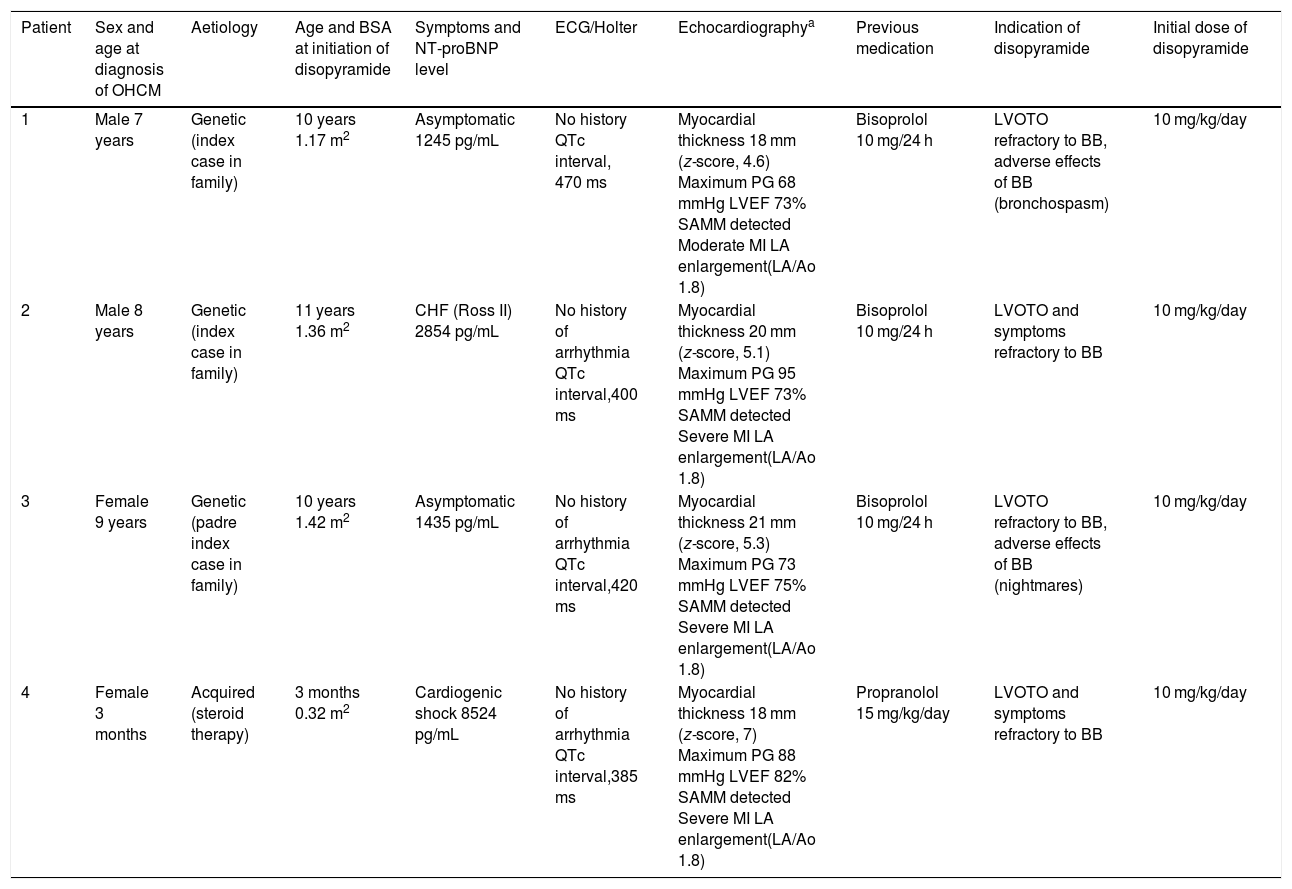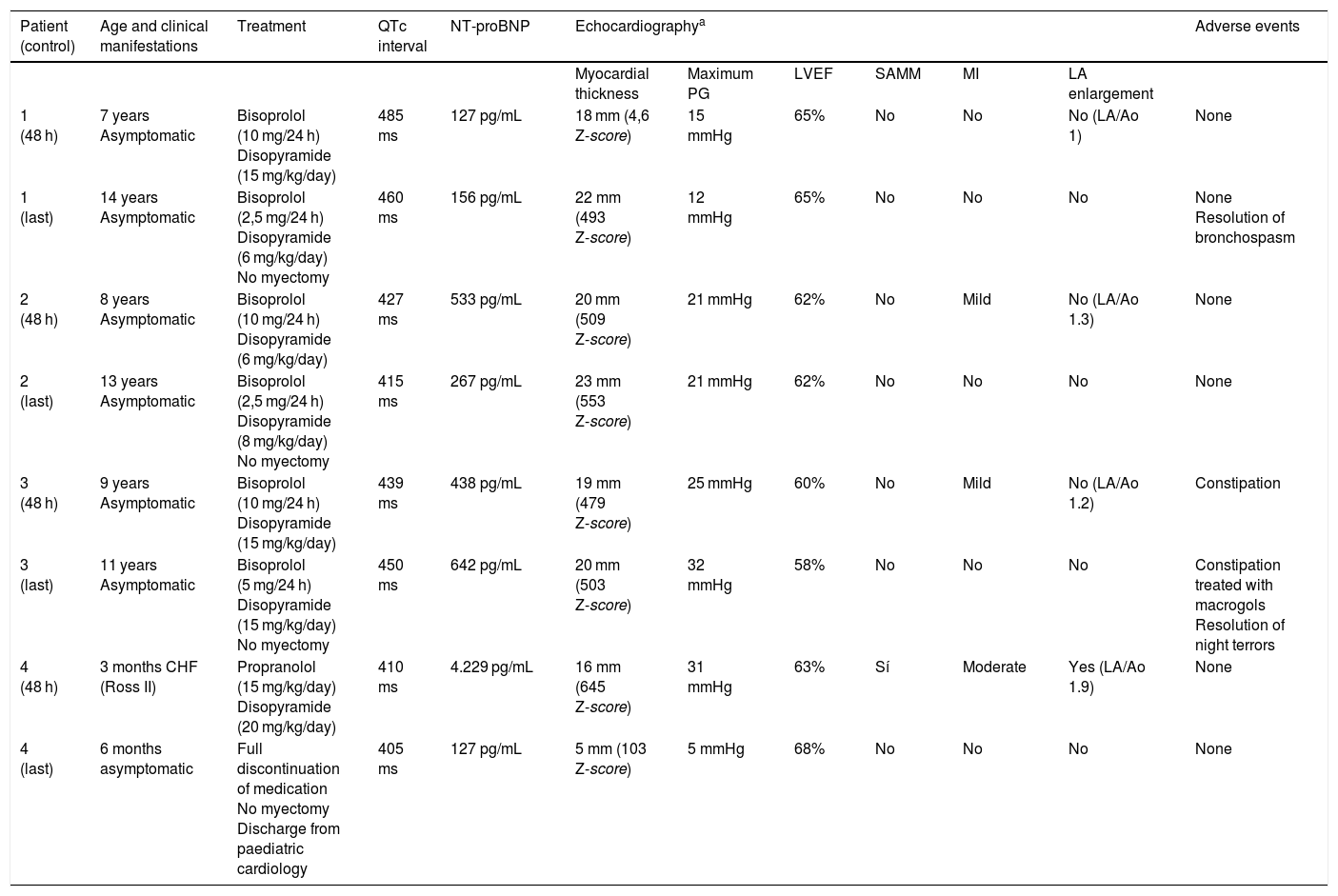The role of left ventricular outflow tract obstruction (LVOTO) in obstructive hypertrophic cardiomyopathy (OHCM) in the paediatric population has yet to be clarified, but it is believed to be a risk modifier or minor risk factor for sudden death, and its management and control of the associated symptoms are among the main goals of treatment in these patients.1 Treatment of LVOTO is recommended in all symptomatic patients and also in asymptomatic patients with a resting peak gradient (PG) greater than 25 mmHg, with the goal of maintaining it below 50 mmHg.1 Some of the treatment options include surgical septal myectomy and percutaneous alcohol septal ablation, but there is limited experience with these interventions in paediatric patients, and pharmacotherapy is the first step of treatment.2 Beta blockers are the first-line therapeutic agents, administered at minimum doses equivalent to 6 mg/kg/day of propranolol.2 However, these drugs are frequently contraindicated, cause side effects or are not effective at the maximum tolerated dose, which requires switching treatment or adding second-line drugs. Although calcium channel blockers are the first alternative used in adults, their use in paediatric OHCM is limited, especially in infants aged less than 1 year, in whom serious adverse reactions have been described.2 Furthermore, they may even be counterproductive in patients with LVOTO due to their peripheral vasodilating effect.
Disopyramide is a class IA oral antiarrhythmic agent that decreases myocardial excitability and conduction velocity and also possesses anticholinergic, peripheral vasoconstrictive and negative inotropic effects. Its efficacy in controlling LVOTO mainly stems from the 2 latter characteristics, and it has performed better in direct comparisons with other drugs in this particular treatment goal.2 There is ample evidence of its efficacy and safety as adjuvant therapy in combination with beta blockers or verapamil in adults. However, the evidence on the use of disopyramide for treatment of paediatric OHCM is scarce. Östman-Smith used disopyramide in 10 patients (mean age, 9 years) out of a cohort of 66 paediatric patients with OHCM for a mean duration of treatment of 8 years, and she found a greater survival and adequate tolerance of the drug in this subset of patients.3 All had severe OHCM, although in some cases disopyramide was not prescribed to manage LVOTO, but as an antiarrhythmic. In addition, all patients were receiving beta blockers at high doses, so the author could not clearly establish a positive impact of survival of disopyramide in itself. O’Connor et al. recently published a case series of 9 patients (mean age, 5.6 years; 4 aged less than 1 year) treated with disopyramide in combination with beta blockers or calcium channel blockers to manage LVOTO, which achieved a median percent reduction of the PG of 58%.4 However, treatment was discontinued in 5 patients during the follow-up (median duration, 2.5 years), which was only due to an adverse event (vomiting) in 1 patient. In all other patients, discontinuation was due to the need to perform a septal myectomy (4) or a heart transplant (1), which suggests that the efficacy of disopyramide to control LVOTO is not maintained in the long term. The rest of the articles in the literature are isolated case reports in which disopyramide was used for rescue therapy in patients that did not respond to other drugs.5,6
Our experience with disopyramide for management of paediatric OHCM was similar (Table 1). We present 4 cases of patients that received this drug to manage symptoms of heart failure and LVOTO, systolic anterior motion of the mitral valve with mitral valve insufficiency and left atrial enlargement, detected by echocardiography, that could not be controlled with high-dose beta blockade, with 2 of the patients developing adverse events at the given doses (severe bronchospasm and sleep disturbances). We sought to highlight the quick clinical and echocardiographic improvement observed in our patients within 48 h of initiating treatment, even in an infant with cardiogenic shock secondary to LVOTO, and the absence of serious adverse events at the administered doses (10−20 mg/kg/day), allowing control of the gradient and symptoms in the long term and delaying the need of myectomy and even allowing a reduction in the beta blocker dose until the associated side effects disappeared. The main limitations of the study were its retrospective design, the small and heterogeneous sample and absence of a control group (Table 2).
Characteristics of the paediatric patients with OHCM treated with disopyramide in our hospital in the 2015-2019 period before initiation of disopyramide.
| Patient | Sex and age at diagnosis of OHCM | Aetiology | Age and BSA at initiation of disopyramide | Symptoms and NT-proBNP level | ECG/Holter | Echocardiographya | Previous medication | Indication of disopyramide | Initial dose of disopyramide |
|---|---|---|---|---|---|---|---|---|---|
| 1 | Male 7 years | Genetic (index case in family) | 10 years 1.17 m2 | Asymptomatic 1245 pg/mL | No history QTc interval, 470 ms | Myocardial thickness 18 mm (z-score, 4.6) Maximum PG 68 mmHg LVEF 73% SAMM detected Moderate MI LA enlargement(LA/Ao 1.8) | Bisoprolol 10 mg/24 h | LVOTO refractory to BB, adverse effects of BB (bronchospasm) | 10 mg/kg/day |
| 2 | Male 8 years | Genetic (index case in family) | 11 years 1.36 m2 | CHF (Ross II) 2854 pg/mL | No history of arrhythmia QTc interval,400 ms | Myocardial thickness 20 mm (z-score, 5.1) Maximum PG 95 mmHg LVEF 73% SAMM detected Severe MI LA enlargement(LA/Ao 1.8) | Bisoprolol 10 mg/24 h | LVOTO and symptoms refractory to BB | 10 mg/kg/day |
| 3 | Female 9 years | Genetic (padre index case in family) | 10 years 1.42 m2 | Asymptomatic 1435 pg/mL | No history of arrhythmia QTc interval,420 ms | Myocardial thickness 21 mm (z-score, 5.3) Maximum PG 73 mmHg LVEF 75% SAMM detected Severe MI LA enlargement(LA/Ao 1.8) | Bisoprolol 10 mg/24 h | LVOTO refractory to BB, adverse effects of BB (nightmares) | 10 mg/kg/day |
| 4 | Female 3 months | Acquired (steroid therapy) | 3 months 0.32 m2 | Cardiogenic shock 8524 pg/mL | No history of arrhythmia QTc interval,385 ms | Myocardial thickness 18 mm (z-score, 7) Maximum PG 88 mmHg LVEF 82% SAMM detected Severe MI LA enlargement(LA/Ao 1.8) | Propranolol 15 mg/kg/day | LVOTO and symptoms refractory to BB | 10 mg/kg/day |
Ao, aorta; BB, beta blockers; BSA, body surface area; CHF, congestive heart failure; LA, left atrium; LA/Ao, left atrial to aortic root ratio; LVEF, left ventricular ejection fraction; LVOTO, left ventricular outflow tract obstruction; MI, mitral valve insufficiency; PG, left ventricular outflow tract peak gradient; SAMM, systolic anterior motion of the mitral valve.
Outcome of patients treated with disopyramide. The data correspond to the evaluation 48 h after initiation of treatment or at the last follow-up.
| Patient (control) | Age and clinical manifestations | Treatment | QTc interval | NT-proBNP | Echocardiographya | Adverse events | |||||
|---|---|---|---|---|---|---|---|---|---|---|---|
| Myocardial thickness | Maximum PG | LVEF | SAMM | MI | LA enlargement | ||||||
| 1 (48 h) | 7 years Asymptomatic | Bisoprolol (10 mg/24 h) Disopyramide (15 mg/kg/day) | 485 ms | 127 pg/mL | 18 mm (4,6 Z-score) | 15 mmHg | 65% | No | No | No (LA/Ao 1) | None |
| 1 (last) | 14 years Asymptomatic | Bisoprolol (2,5 mg/24 h) Disopyramide (6 mg/kg/day) No myectomy | 460 ms | 156 pg/mL | 22 mm (493 Z-score) | 12 mmHg | 65% | No | No | No | None Resolution of bronchospasm |
| 2 (48 h) | 8 years Asymptomatic | Bisoprolol (10 mg/24 h) Disopyramide (6 mg/kg/day) | 427 ms | 533 pg/mL | 20 mm (509 Z-score) | 21 mmHg | 62% | No | Mild | No (LA/Ao 1.3) | None |
| 2 (last) | 13 years Asymptomatic | Bisoprolol (2,5 mg/24 h) Disopyramide (8 mg/kg/day) No myectomy | 415 ms | 267 pg/mL | 23 mm (553 Z-score) | 21 mmHg | 62% | No | No | No | None |
| 3 (48 h) | 9 years Asymptomatic | Bisoprolol (10 mg/24 h) Disopyramide (15 mg/kg/day) | 439 ms | 438 pg/mL | 19 mm (479 Z-score) | 25 mmHg | 60% | No | Mild | No (LA/Ao 1.2) | Constipation |
| 3 (last) | 11 years Asymptomatic | Bisoprolol (5 mg/24 h) Disopyramide (15 mg/kg/day) No myectomy | 450 ms | 642 pg/mL | 20 mm (503 Z-score) | 32 mmHg | 58% | No | No | No | Constipation treated with macrogols Resolution of night terrors |
| 4 (48 h) | 3 months CHF (Ross II) | Propranolol (15 mg/kg/day) Disopyramide (20 mg/kg/day) | 410 ms | 4.229 pg/mL | 16 mm (645 Z-score) | 31 mmHg | 63% | Sí | Moderate | Yes (LA/Ao 1.9) | None |
| 4 (last) | 6 months asymptomatic | Full discontinuation of medication No myectomy Discharge from paediatric cardiology | 405 ms | 127 pg/mL | 5 mm (103 Z-score) | 5 mmHg | 68% | No | No | No | None |
Ao, aorta; BB, beta blockers; BSA, body surface area; CHF, congestive heart failure; LA, left atrium; LA/Ao, left atrial to aortic root ratio; LVEF, left ventricular ejection fraction; LVOTO, left ventricular outflow tract obstruction; MI, mitral valve insufficiency; OHCM, obstructive hypertrophic cardiomyopathy; PG, left ventricular outflow tract peak gradient; SAMM, systolic anterior motion of the mitral valve.
Based on our own experience and the scarce but favourable evidence currently available, we believe that disopyramide may offer a good alternative for adjuvant treatment in paediatric patients with OHCM and LVOTO refractory to beta blockers or in whom the dose of the latter needs to be reduced due to the development of adverse effects, before stepping up to more aggressive treatment, such as septal myectomy. At present, there is no evidence on the use of disopyramide as monotherapy as an alternative to beta blockers when the latter are contraindicated, but this option could be contemplated, especially in infants aged less than 1 year, even in critical cases, such as the patient in our sample, since in this age group, calcium channel blockers are contraindicated and surgery carries a high risk.
Please cite this article as: Rodriguez-Gonzalez M, Pérez-Reviriego AA, Castellano-Martinez A, Cascales-Poyatos HM. Disopiramida como tratamiento coadyuvante en miocardiopatía hipertrófica obstructiva. An Pediatr (Barc). 2021;94:253–256.






